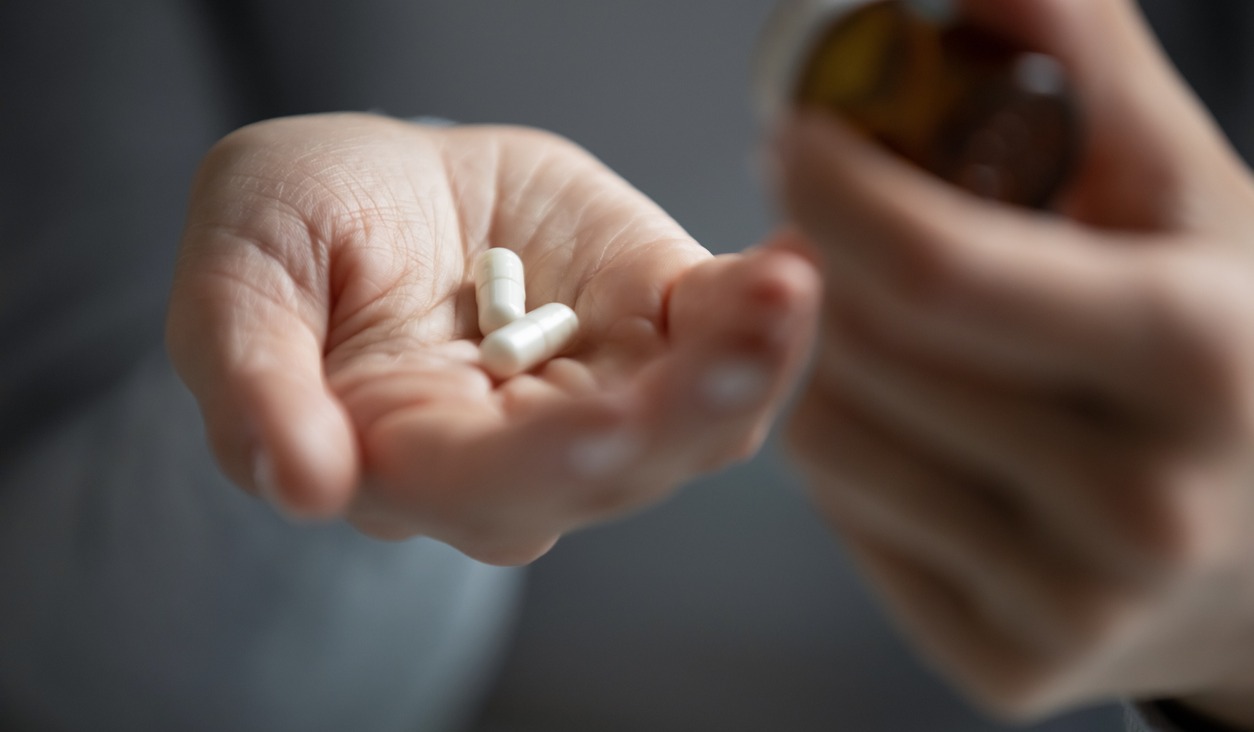Share this
microsampling for TDM of antidepressants in neurodegenerative diseases
by James Rudge, PhD, Technical Director, Trajan on Aug 1, 2022 9:00:00 AM
An article by Laura Mercolini et al at the University of Bologna published in the August 2020 issue of Analyst, reported on a thorough validation of the suitability the hemaPEN® microsampling device for two serotonin reuptake inhibitors intended for therapeutic drug monitoring (TDM) applications. The paper is entitled “Assessment of capillary volumetric blood microsampling for the analysis of central nervous system drugs and metabolites.” It describes the development and validation of fluoxetine, norfluoxetine, sertraline and N-desmethylsertraline from dried blood extracted from DBS samples collected volumetrically using hemaPEN.
/hemaPEN%20images%20(approved)/image-1-1.png?width=224&name=image-1-1.png) The research group was able to fully validate the assay and reported that the original capillary volumetric microsampling procedure using hemaPEN was suitable for the accurate sampling of capillary whole blood. The group proposed that the method could be successfully exploited in self-collection and home-sampling procedures in future and to “pave the way for precision medicine approaches for the treatment of CNS disorders.”
The research group was able to fully validate the assay and reported that the original capillary volumetric microsampling procedure using hemaPEN was suitable for the accurate sampling of capillary whole blood. The group proposed that the method could be successfully exploited in self-collection and home-sampling procedures in future and to “pave the way for precision medicine approaches for the treatment of CNS disorders.”
The Burden & Impact of Neurodegenerative Diseases
Being diagnosed with an incurable neurodegenerative disease is devastating for those affected and those close to them. The strain it causes can lead to severe anxiety and depression. Treatments given to CNS patients often have limited effect and may only treat symptoms. Other treatments may only slow down the progression of the disease. For example, the drug riluzole is one of the only treatments shown to extend life, to a limited degree, in patients with amyotrophic lateral sclerosis (otherwise known as motor neurons disease). If CNS conditions often occur later in life, older patients may already be taking a cocktail of drugs to treat other conditions, such as hypertension, high cholesterol and diabetes. Adding CNS-related medications to an already rigorous medication schedule can cause challenges or complications. Treatment approaches for neurodegenerative diseases typically take a two-pronged approach. Care providers treat the physical effects of the neurodegenerative disease with drug therapies, while also prescribing therapies that treat anxiety and depression for those who are affected. Antidepressants have been shown to be effective for treating depression in those suffering from central nervous system (CNS) disorders. For a number of reasons, therapeutic drug monitoring (TDM) of people who are taking antidepressants is advised, especially for patients who are taking a range of other medications - including those taking drugs active on the central nervous system.
Treatment approaches for neurodegenerative diseases typically take a two-pronged approach. Care providers treat the physical effects of the neurodegenerative disease with drug therapies, while also prescribing therapies that treat anxiety and depression for those who are affected. Antidepressants have been shown to be effective for treating depression in those suffering from central nervous system (CNS) disorders. For a number of reasons, therapeutic drug monitoring (TDM) of people who are taking antidepressants is advised, especially for patients who are taking a range of other medications - including those taking drugs active on the central nervous system.
One such class of antidepressants are the second-generation antidepressants called serotonin reuptake inhibiters (SSRIs). The safety profiles of SSRIs are considered to be more favorable than many first-generation drugs, such as tricyclic antidepressants. SSRIs act by increasing levels of the neurotransmitter serotonin in the brain. Serotonin is associated with increased sense of wellbeing, increased appetite, and regulation of the body clock.
Where does microsampling fit in?
Use of dried matrix remote specimen collection and microsampling, whereby patient-collected specimens can be mailed to a central lab for analysis, helps care teams to more conveniently monitor drug levels in people. Remote microsampling has potential benefits for patients with CNS disorders. One such benefit is that as a CNS disease progresses, mobility and/or cognition become progressively hindered. As a result, clinic visits for onsite bloodwork and health checks become more challenging. With remote microsampling, people can collect their specimen samples in the comfort of their own homes and mail them in. This home sampling approach could be a game-changer for CNS patients and their carers.
To explore the possibilities, the team led by Laura Mercolini investigated the use of the hemaPEN as a potential remote microsampling device for monitoring two SSRIs and metabolites. The hemaPEN is an ideal patient-centric sampling tool for remote TDM. It simultaneously collects four capillary samples from a single source – a finger-prick, for example. After sampling, the end-user places the hemaPEN onto its plastic base and “clicks” it shut. This action transfers the four capillary samples onto 4 pre-cut DBS disks inside the hemaPEN, delivering four homogenous DBS samples secured in the device’s tamper-resistant housing that includes desiccant.
This device is easy to use by most patients, because hemaPEN sampling can be achieved at any angle without the fear of oversampling. In the lab, the internal DBS disks are removed from the device using a special opening tool. and the DBS samples are then extracted by pushing the disks from their cartridge into extractant in a workflow reminiscent of traditional DBS. The critical difference is that the hemaPEN allows for volumetric quantitation.
CNS Study Method and Findings
- SSRIs and metabolites studied were fluoxetine, norfluoxetine, sertraline and N-desmethylsertraline.
- Whole blood capillary samples were collected from healthy volunteers and venous blood samples were obtained from patients for method application.
- Spiked venous blood was used for method validation. Both dried whole blood from hemaPEN collection and wet plasma were compared.
- Method validation was conducted following European Medicines Agency (EMA) and US Food and Drug Administration (FDA) guidelines on bioanalytical method validation but also taking DBS-specific parameters into account.
- The hemaPEN samples (n=6, 2.74 µL) were shown to collect blood at high levels of accuracy (102%) and precision (1.9% RSD).
- Extraction optimization was carried out and 50 µL of MeOH sonicating for 30 minutes and the supernatant was then centrifuged and injected onto the LC-MS/MS system for quantitation.
- Excellent linearity was seen for all target compounds r2 ≥ 0.9991 across 3 orders of magnitude.
- Extraction yields were > 81% for all analytes and precision was well within accepted criteria as well as acceptable carryover.
- Matrix effects were all below 8% and all compounds at low-high QC levels were well within ± 15% acceptance criteria across a hematocrit (HCT) range (30, 50 and 70% HCT).
- Stability was shown to be excellent for all compounds with less than 5.2% loss for five days at 50° C and 6.3% at room temperature for at least 3 months.
- Under- and over-sampling were evaluated by sampling blood at different durations (10 seconds is recommended in the IFU). No over-sampling was observed even at 20 seconds sample time. The minimum time where all 4 spots were sampled was 8 seconds.
- At 6 seconds, 2 complete spots were sampled leaving 2 blanks
- At 4 seconds this was down to 1 completed spot plus 3 blanks
- At 2 seconds, all blanks
Study Authors’ Conclusions
The fully validated method from hemaPEN extracts, provided reliable and sound analytical results and allowed for assessment of the potential application of sampling patients on CNS disorder patients on antidepressants. The high throughput method was straightforward to allow for reliable TDM of such patients. The sampling accuracy and robustness showed promising results, “remarkable” analyte stability, and “outstanding” HCT-independence. The hemaPEN tool has high potential for a home sampling approach to therapeutic drug monitoring to allow for more frequent sampling that would allow better clinical decision making and therapy personalization.Neoteryx Comments
The authors should be commended on such a thorough analytical validation and device evaluation. The importance of providing patients with an option for self- or assisted sampling cannot be underestimated, especially for those who are debilitated with disorders that cause loss of mobility and/or cognition. Volumetric dried blood microsampling, whatever the chosen tool, really demonstrates the feasibility of how care can be continued remotely to allow those affected to minimize unnecessary travel to clinics and experience less invasive sampling. Moreover, remote devices offer the potential for more frequent sampling to further tailor treatment for those affected by devastating disorders.
This article was summarized for our readers by James Rudge, PhD, Neoteryx Technical Director. This is curated content. To learn more about the important research outlined in this blog, visit the original article in Analyst.
Image Credits: iStock, Neoteryx, Trajan Scientific and Medical
You can access this microsampling article and others in our Technical Resource Library.
Share this
- Microsampling (206)
- Research, Remote Research (119)
- Venipuncture Alternative (105)
- Clinical Trials, Clinical Research (83)
- Mitra® Device (73)
- Therapeutic Drug Monitoring, TDM (51)
- Dried Blood Spot, DBS (39)
- Biomonitoring, Health, Wellness (30)
- Infectious Disease, Vaccines, COVID-19 (24)
- Blood Microsampling, Serology (23)
- Omics, Multi-Omics (21)
- Decentralized Clinical Trial (DCT) (20)
- Specimen Collection (18)
- Toxicology, Doping, Drug/Alcohol Monitoring, PEth (17)
- Skin Microsampling, Microbiopsy (14)
- hemaPEN® Device (13)
- Preclinical Research, Animal Studies (12)
- Pharmaceuticals, Drug Development (9)
- Harpera Device (7)
- Industry News, Microsampling News (5)
- Antibodies, MAbs (3)
- Company Press Release, Product Press Release (3)
- Environmental Toxins, Exposures (1)
- July 2025 (1)
- May 2025 (1)
- April 2025 (2)
- December 2024 (2)
- November 2024 (1)
- October 2024 (3)
- September 2024 (1)
- June 2024 (1)
- May 2024 (1)
- April 2024 (4)
- March 2024 (1)
- February 2024 (2)
- January 2024 (4)
- December 2023 (3)
- November 2023 (3)
- October 2023 (3)
- September 2023 (3)
- July 2023 (3)
- June 2023 (2)
- April 2023 (2)
- March 2023 (2)
- February 2023 (2)
- January 2023 (3)
- December 2022 (2)
- November 2022 (3)
- October 2022 (4)
- September 2022 (3)
- August 2022 (5)
- July 2022 (2)
- June 2022 (2)
- May 2022 (4)
- April 2022 (3)
- March 2022 (3)
- February 2022 (4)
- January 2022 (5)
- December 2021 (3)
- November 2021 (5)
- October 2021 (3)
- September 2021 (3)
- August 2021 (4)
- July 2021 (4)
- June 2021 (4)
- May 2021 (4)
- April 2021 (3)
- March 2021 (5)
- February 2021 (4)
- January 2021 (4)
- December 2020 (3)
- November 2020 (5)
- October 2020 (4)
- September 2020 (3)
- August 2020 (3)
- July 2020 (6)
- June 2020 (4)
- May 2020 (4)
- April 2020 (3)
- March 2020 (6)
- February 2020 (3)
- January 2020 (4)
- December 2019 (5)
- November 2019 (4)
- October 2019 (2)
- September 2019 (4)
- August 2019 (4)
- July 2019 (3)
- June 2019 (7)
- May 2019 (6)
- April 2019 (5)
- March 2019 (6)
- February 2019 (5)
- January 2019 (8)
- December 2018 (3)
- November 2018 (4)
- October 2018 (7)
- September 2018 (6)
- August 2018 (5)
- July 2018 (8)
- June 2018 (6)
- May 2018 (5)
- April 2018 (6)
- March 2018 (4)
- February 2018 (6)
- January 2018 (4)
- December 2017 (2)
- November 2017 (3)
- October 2017 (2)
- September 2017 (4)
- August 2017 (2)
- July 2017 (4)
- June 2017 (5)
- May 2017 (6)
- April 2017 (6)
- March 2017 (5)
- February 2017 (4)
- January 2017 (1)
- July 2016 (3)
- May 2016 (1)
- April 2016 (2)



No Comments Yet
Let us know what you think